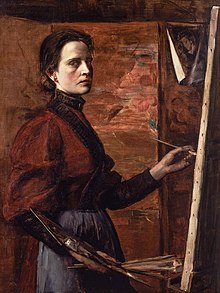Elizabeth Nourse
| Elizabeth Nourse | |
|---|---|

self-portrait from 1892
|
|
| Born |
October 26, 1859 Mount Healthy, Ohio |
| Died | October 8, 1938 (aged 78) Paris, France |
| Nationality | American |
| Education | McMicken School of Design, Académie Julian, Gustave Boulanger, Art Students League of New York |
| Known for | Painting |
| Movement | Realist |
| Awards | 1921 Laetare Medal (Notre Dame University); Gold Medal, Panama-Pacific International Exhibition, San Francisco (1915) |
| Elected | Société Nationale des Beaux-Arts |
Elizabeth Nourse (born October 26, 1859 – October 8, 1938 (aged 78)) was a realist-stylegenre, portrait, and landscape painter born in Mt. Healthy, Ohio, in the Cincinnati area. She also worked in decorative painting and sculpture. Described by her contemporaries as "the first woman painter of America" and "the dean of American woman painters in France and one of the most eminent contemporary artists of her sex," Nourse was the first American woman to be voted into the Société Nationale des Beaux-Arts. She also had the honor of having one of her paintings purchased by the French government and included in the Luxembourg Museum's permanent collection. Nourse's style was described by Los Angeles critic Henry J. Seldis as a "forerunner of social realist painting." Some of Nourse's works are displayed at the Cincinnati Art Museum.
Born to the Catholic household of Caleb Elijah Nourse and Elizabeth LeBreton Rogers Nourse on October 26, 1859, Elizabeth and her twin sister were the youngest of ten children. She attended the McMicken School of Design in Cincinnati (now the Art Academy of the Cincinnati Art Museum) at age fifteen, and was one of the first women admitted to the women's life class offered there taught by Thomas Satterwhite Noble. She also studied watercolor painting while there. She studied at the school for seven years and was even offered a teaching position, which she declined in order to focus on her painting.
In 1882, both of her parents died, and with the assistance of an art patron, she went to New York City to continue her studies, briefly in the Art Students League. In 1883, she had returned to Cincinnati and made her living decorating home interiors and painting portraits. From 1884 – 1886, she spent most of her summers in Tennessee in the Appalachian Mountains doing watercolor landscapes.
...
Wikipedia
